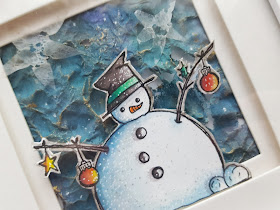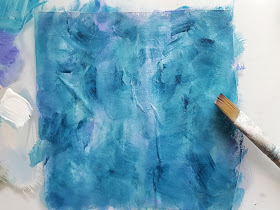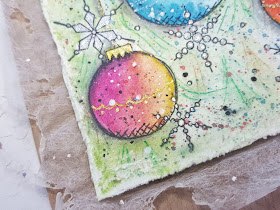2017 Topic 18: Torn, Ripped, Burnt
It's always a treat when one of our bloggers lets you inside their head; explains how they think, how they create, how they arrange... and it's super-fun when that head belongs to Lynne Moncrieff!
Hi everyone, it's Lynne Moncrieff, Adorn, with
you today, and I'd like to share with you a project which found me
immersed in my comfort zone where I dipped into many of my tried and
trusted favourites to achieve a torn, ripped appearance. I will throw
my hands up in the air, I did not actually burn any items! In my
defence, I hope that some of the elements have a burnt appearance even
though I did not set light to anything.
The beauty of such a project, items can be hunted and gathered from around the home and garden, a perfect project for re-cycling textiles, found papers and all manner of goodies. Investing some preparation time in tea/coffee staining and placing bundles of gathered items outside to weather/rust will pay you in dividends. When moving onto creating the project, there is a wealth of stained and weathered items to select from.
I worked with the wonderful PaperArtsy Vintage Ink and the Dog Collection: set 06, the woman on tag stamp being the central figure in the narrative, the other stamps playing an important supportive role in her story. The high quality of PaperArtsy stamps ensured that I had confidence they would stamp onto a variety of collected surfaces:
I
will happily while away time preparing bundles. Vintage tart tins,
wrapped with a mixture of textiles and papers, alongside vintage keys,
crochet lace, safety pins.... laid outside, either doused in vinegar,
tea or coffee with Mother Nature bringing rain and wind to distress the
various items.
I never tire of tea and/or coffee baths. I used them in two ways, to stain virgin items as above but also placing some of the items that had already been outside, playing around with items which have been weathered and then dipping them into the baths, lots of interesting variations can take place, sometimes producing a very dark, almost black/grey colour.
Vintage ID06
Having
a plethora of prepared papers, textiles and extras to stamp onto is in
itself inspirational especially when the stamp designs are so in tune
with the aged appearance of the papers and textiles, as though each
fragment has been unearthed from the past.
When working on such a multi-layered project, I have learned that there is a moment of restraint required from wanting to stamp everything in sight, ultimately there is a fine line, a balancing act of placing stamped elements alongside elements which are allowed to breathe, with no addition of stamping as they paint the narrative as much as stamped pieces.
Sometimes with layers, whether paint, stamping or textiles, they might not be evident to a viewer but that does not make them any less worthy of being included in a project. For me, layers bring intrigue and in this project the layers symbolize the layers of her life, as though she might be flicking through the pages of her mind, looking at her past.
A wooden vintage clothes peg and craft peg, given a slightly burnt appearance from being weathered with the addition of dipped into a coffee bath. The clothes peg brings visual weight to the top of the assemblage, layered onto a variety of textiles all with torn, raggedy edges, including the fragment of lace which tops of the focal images.
When editing photos, my eye was caught by the fact that this element could be a mini assemblage, ideas already circulating in my head for future projects. .
Torn, ripped edges of found papers, cardboard paper, calico, all previously stained and weathered with the addition of some of the edges being dipped into coffee or tea, with loose hand-stitched threads adding to the overall distressed appearance, as though memories that are fragile, about to be whisked off in a passing breeze as she desperately tries to grasp hold of those fading memories.
When you take the time to stain, rust, weather, it connects you even moreso with your project. Although ultimately, you cannot control the outcome of any of those processes, you are invested as you patiently wait for the result to unfold.
Try, if possible to re-cycle items or utilize found items as it is so rewarding when those items are transformed into a project. When sourcing items, keep in mind that a variety of surfaces will not only bring more visual interest to your project, it also heightens the pleasure of stamping and can sometimes result in viewing a stamp with new eyes.
For me, such projects are layers of joy. From the moment I begin gathering items to the staining and weathering,I treasure those times as they are meditative, a time when the creative brain is on a different frequency, allowing ideas to brew. It is also a time to simply experiment, play around with different textures, notice how some tear/rip differently creating different torn edges, some might not stain, rust as successfully as others.
As for the tea baths, add a dash of Infusions. There is no right or wrong so long as you ensure you are not working with fumes, anything which could be toxic and be careful when handling rusted items, in other words, be creative and play but keep safety in mind.
My mind is already brewing with project ideas and yes, next time I will be burning something up!
Patiently
waiting for the items to be weathered, broken down, rusted, a little
bit battered and torn, before bringing indoors to dry thoroughly. A
beautiful tactile collection of textures in a variety of colour tones
which will sit side by side harmoniously.
The
pleasure in rooting around home and garden, discovering items to
incorporate into projects, items which might appear insignificant at
first sight but the magic is, they will soon become part of the story
that is woven into the artwork.
I never tire of tea and/or coffee baths. I used them in two ways, to stain virgin items as above but also placing some of the items that had already been outside, playing around with items which have been weathered and then dipping them into the baths, lots of interesting variations can take place, sometimes producing a very dark, almost black/grey colour.
Vintage ID06
When working on such a multi-layered project, I have learned that there is a moment of restraint required from wanting to stamp everything in sight, ultimately there is a fine line, a balancing act of placing stamped elements alongside elements which are allowed to breathe, with no addition of stamping as they paint the narrative as much as stamped pieces.
Sometimes with layers, whether paint, stamping or textiles, they might not be evident to a viewer but that does not make them any less worthy of being included in a project. For me, layers bring intrigue and in this project the layers symbolize the layers of her life, as though she might be flicking through the pages of her mind, looking at her past.
A wooden vintage clothes peg and craft peg, given a slightly burnt appearance from being weathered with the addition of dipped into a coffee bath. The clothes peg brings visual weight to the top of the assemblage, layered onto a variety of textiles all with torn, raggedy edges, including the fragment of lace which tops of the focal images.
When editing photos, my eye was caught by the fact that this element could be a mini assemblage, ideas already circulating in my head for future projects. .
Torn, ripped edges of found papers, cardboard paper, calico, all previously stained and weathered with the addition of some of the edges being dipped into coffee or tea, with loose hand-stitched threads adding to the overall distressed appearance, as though memories that are fragile, about to be whisked off in a passing breeze as she desperately tries to grasp hold of those fading memories.
When you take the time to stain, rust, weather, it connects you even moreso with your project. Although ultimately, you cannot control the outcome of any of those processes, you are invested as you patiently wait for the result to unfold.
Try, if possible to re-cycle items or utilize found items as it is so rewarding when those items are transformed into a project. When sourcing items, keep in mind that a variety of surfaces will not only bring more visual interest to your project, it also heightens the pleasure of stamping and can sometimes result in viewing a stamp with new eyes.
For me, such projects are layers of joy. From the moment I begin gathering items to the staining and weathering,I treasure those times as they are meditative, a time when the creative brain is on a different frequency, allowing ideas to brew. It is also a time to simply experiment, play around with different textures, notice how some tear/rip differently creating different torn edges, some might not stain, rust as successfully as others.
As for the tea baths, add a dash of Infusions. There is no right or wrong so long as you ensure you are not working with fumes, anything which could be toxic and be careful when handling rusted items, in other words, be creative and play but keep safety in mind.
My mind is already brewing with project ideas and yes, next time I will be burning something up!
Blog: Adorn https://lynnesbowsandbelles.wordpress.com/
Facebook: https://www.facebook.com/lynne.moncrieff
Instagram: https://www.instagram.com/stampingandbeyond/
Pinterest:https://www.pinterest.co.uk/lynnemoncrieff/
You do this beautifully! I love the loosely gathered and gently stitched elements, dangling thread, frayed lace, newly stamped papers that look old and weathered. It all comes together with your attention to detail in such a thoughtful manner! Taking time to enjoy the process certainly reaps rewards!Thank you for such an insightful post! ~Leandra
We always hope that you learn something interesting from our blog.
Our creative team love to read your comments so much, so please take time to let them know you've been inspired!
Why not join our 2-weekly challenge by blogging your create response to the current topic and link it here?
Our creative team love to read your comments so much, so please take time to let them know you've been inspired!
Why not join our 2-weekly challenge by blogging your create response to the current topic and link it here?
The current topic link Topic 18: Torn, Ripped, Burnt will close 17:00 (London Time) Sunday, 10th December 2017, and the winner will be announced 2 hours later at 19:00.
All links go in the draw to win a £50 voucher to spend on products of your choice from the PaperArtsy online store.
All links go in the draw to win a £50 voucher to spend on products of your choice from the PaperArtsy online store.
















































